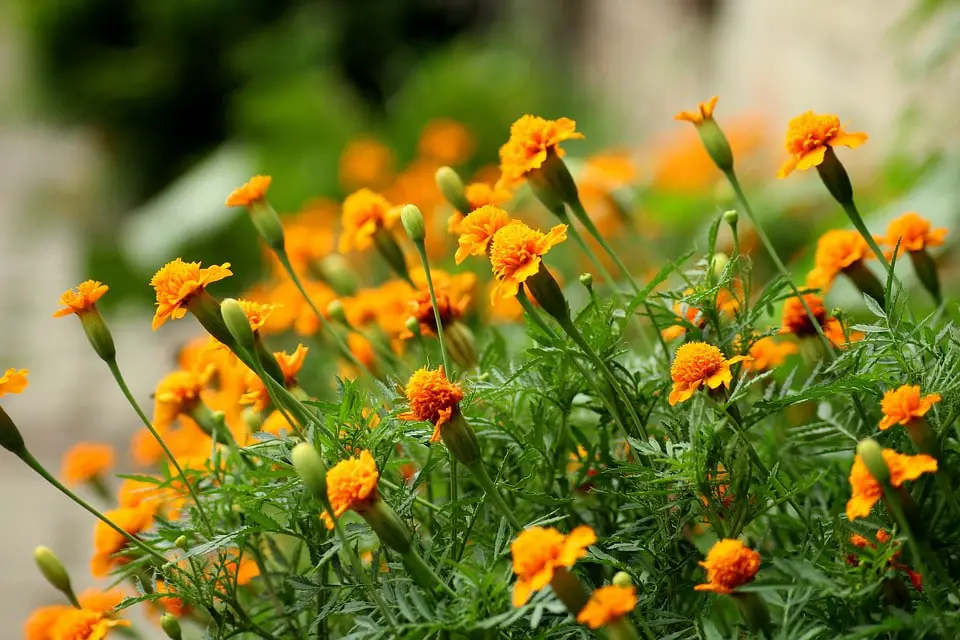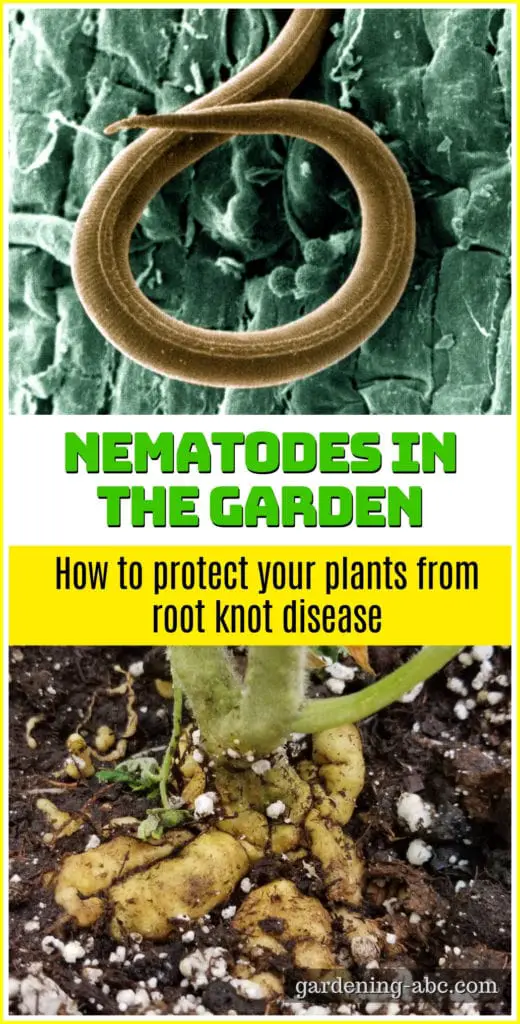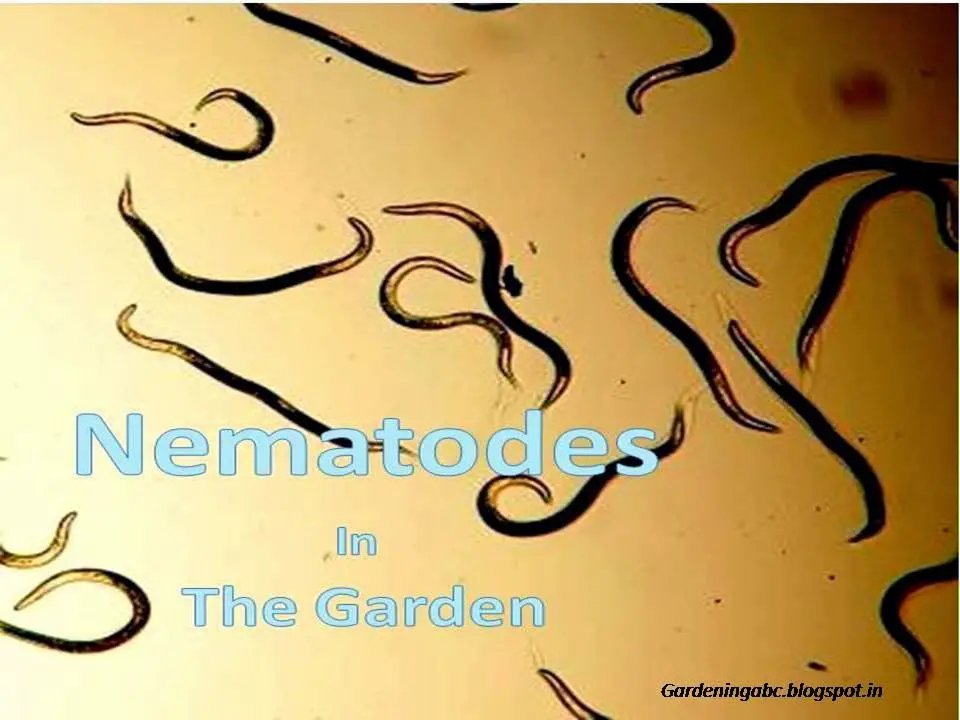We use affiliate links to run our site. When you buy through links on our site, we may earn an affiliate commission, without any added cost to you. Learn more
Nematodes are tiny, microscopic creatures that can be both beneficial and detrimental to your garden.
Some species of nematodes are plant-parasitic, causing harm to garden plants by feeding on their roots and other tissues. However, there are also types of nematodes that can be beneficial to gardens, serving as natural predators of pest insects and other invertebrates.
Understanding the role of nematodes in the garden ecosystem is crucial for successful pest management and maintaining a healthy and thriving garden.
In this article, we’ll take a look at what nematodes are and discuss some of the best methods for controlling them in the garden.
What Are Nematodes?
By definition, nematodes are microscopic, small roundworms. They live in the soil and can cause great damage to the roots of the plants.
They interrupt plants’ normal process of taking water and other nutrients through the roots by burrowing into them. As a result, various knobs are formed in the roots of the plant. For successful gardening, control of nematodes is essential.
The most common of all the garden nematodes is the root-knot nematode (which causes knots to the roots of many vegetables). Root-knot nematodes affect a vast range of plants including Potatoes, tomatoes, cucumbers, carrots, roses, etc.
The nematode infection is more common in sandy soil. They cause shunted and low or no yielding plants.
Types of nematodes:
Nematodes can be of various types based on their habitat, feeding habits, and other characteristics. Some common types of nematodes include:
- Plant-parasitic nematodes: These nematodes feed on the roots and other tissues of plants, causing damage and reducing plant health. Examples include root-knot nematodes and lesion nematodes.
- Animal-parasitic nematodes: These nematodes infect and feed on animals, including humans. Examples include heartworms and hookworms.
- Free-living nematodes: These nematodes do not feed on plants or animals and are not parasitic. They can be found in soil, water, and other environments, and may serve as decomposers or predators of other invertebrates.
There are also beneficial nematodes, also known as entomopathogenic nematodes (EPNs), which are natural predators of pest insects and other invertebrates. You can use these nematodes in gardens and other environments as a natural pest control method.
How Do Nematodes Affect Plants?
The plant-parasitic nematodes can cause damage to plants by feeding on their roots and other tissues. They can infect a wide range of plants, including vegetables, fruits, ornamentals, and turf grass.
These plant-parasitic nematodes feed on the roots and other tissues of plants, which can cause all sorts of problems. If you’ve ever had a plant that just wasn’t growing quite right, or had yellowing or wilting leaves, it’s possible that nematodes could be the culprit.
These little buggers can also cause stunted root systems and create galls or knots on roots.
Plant-parasitic nematodes can also vector plant viruses, increasing the severity of the damage caused by the virus. In extreme cases, nematode infestation can lead to plant death.
The severity of the damage depends on the species of nematode, the stage of plant growth, and the overall health of the plant.
Regularly monitor your plants for signs of nematode infestation and take appropriate control measures to prevent or manage the problem.
Symptoms of nematode damage in plants:
Some common symptoms of nematode damage in plants include:
- Stunted or distorted plant growth
- Yellowing or wilting of plants
- Stunted root systems
- Presence of galls or knots on roots
It’s important to note that these symptoms can be caused by a variety of factors, not just nematodes. It’s always a good idea to properly diagnose the problem before implementing control measures.
Other signs of nematode infestation in plants may include:
- Reduced fruit or flower production
- Stunted seedlings or seedling death
- Poor plant vigor
- Premature death of plants
If you suspect that your plants are being affected by nematodes, take action as soon as possible to prevent further damage.
How to Control Nematodes in Home Garden?
As they say, prevention is better than cure. There is hardly anything you can do to treat the infected plants. The best methods are preventive in nature.
There are several ways you can prevent a nematode infection:
Crop rotation:
Experts suggest that crop rotation is the best way to take control of nematodes. Planting non-susceptible crops in infested areas can help to reduce the population of nematodes.
Nematodes typically have specific host plants, and rotating the crops in an area can reduce the number of host plants available for the nematodes to feed on.
This can help to reduce the overall population of nematodes and minimize the risk of damage to susceptible crops. Please plan the schedule carefully so the non-susceptible crops grow at appropriate intervals.
Solarization:
Solarization is a simple method of covering the soil with clear plastic during the hot summer months. Although it sounds very simple it can help you kill nematodes and other soil-borne pests quite easily.
The heat trapped under the plastic can help to raise the temperature of the soil to levels that are lethal to many nematodes and other pests.
Solarization is most effective when the soil is moist and the air temperature is hot, and it can be particularly useful for controlling nematodes in areas where chemical control is not an option.
You can read more about this method here in this post.
Use of nematode-resistant plant varieties:
Some plant varieties have been developed to be resistant to certain species of nematodes. Using these varieties can help to reduce nematode damage.
First, carefully research the nematode species present in your area and then select plant varieties that are resistant to these nematodes.
Use of nematicides:
There are several nematicides that you can use to control nematodes. These products work by killing or inhibiting the growth of nematodes.
It is important to carefully consider the potential risks and benefits of using nematicides before implementing them in the garden.
We suggest rather than going for any chemical nematicide choose neem cakes. Neem cake is a byproduct of neem oil production and is made from the residue of crushed neem seeds. It contains a number of active compounds that are toxic to nematodes and other pests, including azadirachtin and salannin.
It is most effective when applied to the soil before planting, as the active compounds in neem cake can help to prevent nematode infestation.
Neem cake can also be used as a natural fertilizing agent, helping to improve soil health and plant growth. You can read more about how neem cakes can help you control the nematode population here in this post.
Plant Marigolds:

Marigold plants (Tagetes spp.) have nematicidal properties and can be effective in controlling nematodes in the garden. The roots of the plants contain compounds called alpha-terthienyl and other terpenoids, which are toxic to nematodes and other pests.
Marigold plants can be used as companion plants in the garden to help control nematodes. They can also be used as mulch around susceptible plants to help prevent nematode infestation.
Please note, the effectiveness of marigold plants as a control method for nematodes may vary depending on the species of nematode present and the overall health of the plants. They may not be very effective against all species of nematodes and may not provide complete control.
It is always a good idea to use a combination of control methods and to properly diagnose the problem before implementing control measures.
Introduction of nematode-predators:
You can also introduce predatory nematodes and fungi to the soil to help control plant-parasitic nematodes. Predatory nematodes feed on other nematodes, while fungi infect and kill nematodes.
These natural control methods can be an effective way to reduce nematode populations and minimize the risk of damage to plants.
Always research and select the appropriate predatory nematodes or fungi carefully, for the nematode species present in your area.
Maintain good soil health:
A healthy soil itself acts as a buffer to nematode problems. In healthy soil, both nematodes, as well as their parasites (various microorganisms), are present, and they will keep the nematode population in check. You can keep your soil healthy by regularly adding compost, manures, and mulch.
Some Key Points To remember:
Always consider the potential risks and benefits of each control method before implementing it in the garden. In addition, it is important to properly diagnose the problem and confirm that nematodes are the cause of the damage before implementing control measures.
Not all nematodes present in the soil are bad for plants. There are several beneficial nematodes are present in the soil which helps in checking other pest problems for the plant.
Nematodes can rarely move a long distance. In most cases, diseases are spread by human interference. So the more hygiene you maintain in your garden lesser the chances of spreading.
Conclusion:
Nematodes can be a nuisance in the garden, but they don’t have to be. By taking a few simple steps, such as improving soil health, applying beneficial nematodes, and keeping up with regular maintenance, you can easily control these pesky parasites and keep your garden thriving.
It is essential for every gardener to understand what nematodes are and how to manage them properly. Take action now to protect your plants from nematodes and enjoy the fruits of your labor!
I hope this post was helpful to you. You can learn more about nematodes here in this post.
Like the article? Share it with your friends and Don’t Forget to PIN IT.

Amazon and the Amazon logo are trademarks of Amazon.com, Inc, or its affiliates.
